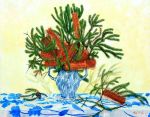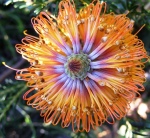“Banksia seeds collected by the Lapérouse Expedition “ By Henri Colombié
In Nos. 43 and 44 of the ‘Journal de bord’, we touched on the experiment attempted by the Conservatoire national botanique [National Botanical Conservatory] of Brest, an organization engaged in the preservation of diversity in the wild plants of the national patrimony, to germinate the Banksia seeds that had been collected from the wreck of the Boussole at Vanikoro by divers of the Solomons Association and preserved in Nouméa. On the advice of Alain Conan, we then got in touch with Dr Stéphane Buord, Director of International Scientific Relations at the Conservatory.
This delicate experiment was carried out with the help of INRA (Institut National de la Recherche Agronomique) in Dijon [National Institute for Agricultural Research – this is the No.1 agricultural institute in Europe and no.2 in the world], of Végénov, a technical centre specializing in plants in Saint Pol de Léon (Finistère), of the Australian Embassy, and of the Institut Klorane of Fabre Laboratories (thus the Tarn [Region] was represented in the operation). A scientific protocol was established with its objective being “to detect the presence of living matter inside the seeds and, from this matter, to regenerate complete plants in order to give to the people of Brest a Banksia collected by Lapérouse”.
On the 4th July last, in the surroundings of the Bibliothèque Lapérouse [Lapérouse Library] in Brest, the very place where we held our exhibition devoted to the navigator from Albi, the results of this exciting experiment were revealed at a press conference. Herewith some of the highlights:
“The INRA of Dijon was in charge of the preliminary microscopic examination of the seeds to detect the presence of living tissue, and Végénov [was in charge of] the research for [developing] a plant biotechnology [process] capable of regenerating plants from embryos or cell clumps that were observed.
With the aim of obtaining reference pictures to compare with the ancient seeds, present-day seeds were gathered in 2010 from the very site where Lapérouse had carried out his collecting 222 years earlier. Observations with the both the photon and electron microscopes were then carried out on the ancient seeds. The results were astonishing! They showed well-preserved tissues, easily identifiable, whose contents unfortunately had been more or less greatly altered. Lapérouse’s Banksia seeds therefore did not contain any presence of life to permit their regeneration.”
But, beyond the disappointment of not being able to germinate the seeds collected by Lapérouse, it is above all necessary to remember the development of an ‘exemplary scientific protocol which opens the way to an original research project: to regenerate wild plants, which have disappeared, from seeds in herbariums or soil banks by taking inspiration from the research and techniques on display.”
Thus the botanist Lamartinière or the gardener Collignon, in gathering a few seeds of Banksia ericifolia during the stopover at Botany Bay, were a very long way from imagining that perhaps one day they would be indirectly involved in the regeneration of plants that had been lost!
The above article appeared in the ‘Journal de bord’, No 53, Autumn 2012, the journal of the Association Lapérouse Albi France, and the translation was performed by Dr W Land AM. It appears by kind permission of M. Henri Féral, the president and editor, of the Association Lapérouise Albi-France.
(L-R: Pamela Griffith painting of Banksia ericifolia and close up taken in La Perouse; On Display in the Musée Maritime de Nouvelle-Calédonie courtesy Greg Bond).
Banksia ericifolia: the genus was named by Carl Linneaus (son of Linneaus) for Joseph Banks who with Daniel Solander collected Banksia ericifolia as well as B.serrata and B.integrifolia in Botany Bay in 1770.




You must be logged in to post a comment.